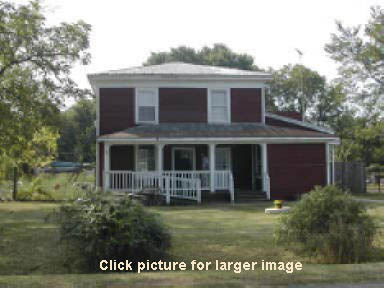|
 The
Graffiti House is a red building located at 19484 Brandy Road in
the eastern end of the town of Brandy Station, Virginia. The Brandy
Road (Rt. 762) runs parallel to the railroad tracks as they pass
through the town of Brandy Station, and the house is between the
railroad tracks and Route US 15/29. It was purchased by the Brandy
Station Foundation in August, 2002. The
Graffiti House is a red building located at 19484 Brandy Road in
the eastern end of the town of Brandy Station, Virginia. The Brandy
Road (Rt. 762) runs parallel to the railroad tracks as they pass
through the town of Brandy Station, and the house is between the
railroad tracks and Route US 15/29. It was purchased by the Brandy
Station Foundation in August, 2002.
The Graffiti House is a two-story frame structure, believed to have
been built in 1858. It was built directly beside the railroad
tracks, suggesting that its function included some type of
commercial aspect. Proprietors of whatever business was likely
here may have also resided in the building. Local tradition
holds that the building was used as a hospital by both Union and
Confederate forces. The walls of the
second floor contain inscriptions, drawings, messages, and
signatures of Civil War soldiers, hence the name “Graffiti House.”
The graffiti could have been
made by soldiers recuperating in the hospital, by other soldiers
posted at Brandy Station, or by soldiers passing through the town.
Brandy Station was a strategic location and a junction of the Orange
and Alexandria Railroad, and of roads leading to Kelly’s Ford and
Beverly’s Ford on the Rappahannock River. Fleetwood Hill provided
high ground suitable for both observation and a defensive position.
Previous owners acknowledge
that some of the graffiti has been destroyed, and other pieces have
been removed by parties unknown. However, much of the graffiti
still survives and these writings are believed to be one of the most
extensive collections of Civil War era graffiti discovered in recent
decades.
Research on the history of the
structure is still needed. Courthouse records indicate that the
building has had at least twelve different owners. Verification of
its uses through time, including documentation of its use during the
Civil War has yet to be done. The building’s west addition is
recent, but an architectural analysis is also needed to provide
documentation of how the building itself has changed over the years,
and what architectural and archaeological evidence suggests about
the use and appearance of the building.
The building was apparently
owned by James Barbour during the Civil War. Barbour’s home was the
prominent structure known as Beauregard, which still stands today
about 1-½ miles to the north of Brandy station. Barbour initially
argued against secession, but when Lincoln’s inaugural address
failed to include certain concessions Lincoln cabinet members had
led Barbour to believe would be contained within the address,
Barbour ardently supported the withdrawal of Virginia from the
Union. After the First Battle of Manassas, fought July 21, 1861,
Confederate casualties were evacuated by train, and Brandy Station
became a hospital site. This is likely the first time that the
Graffiti House was used as a hospital. Barbour’s home was also used
as a hospital, and one the patients recovering their was Major
Roberdeau Wheat, commander of the Louisiana Tigers. Major Wheat
requested that Barbour change the name of his home to “Beauregard”
in honor of Confederate General Pierre G. T. Beauregard, who
directed the Battle of First Manassas. Barbour served on the staff
of General Richard S. Ewell. During the most prominent of the
various battles fought at Brandy Station on June 9, 1863, Robert E.
Lee and Ewell observed part of the action, including a Federal
cavalry charge that almost made it to the house.
During the Battle of Brandy
Station the Federal cavalry division of David McMurtrie Gregg
arrived in the town of Brandy Station late on the morning of June 9,
1863. His troopers formed up within view of the Graffiti House and
charged Fleetwood Hill, also visible through the windows of the
house. Some of the graffiti identified on the walls are from
soldiers known to have been wounded in that battle. While we cannot
be certain, there is a possibility that these troopers could have
recovered in the Graffiti House and it could have been in the
aftermath of the battle when these men scrawled their names upon the
walls.
The earliest date thus far
deciphered (and still present on the Graffiti House walls), is for
mid-April of 1863. At that time Federal cavalry crossed the
Rappahannock River at Beverly’s Ford, to initiate the
Chancellorsville Campaign. A rain and hail storm, as well as
resistance from Confederate cavalryman in Fitzhugh Lee’s brigade,
forced the Federal force to withdraw, and one of Lee’ men is likely
to be the person who scrawled a brief account of the action by
stating the “Yanks caught hell.”
The house has been recently renovated, and is in sound condition.
It is also the headquarters of the Brandy Station Foundation.
Return to top
Home
Visit the Graffiti
House |